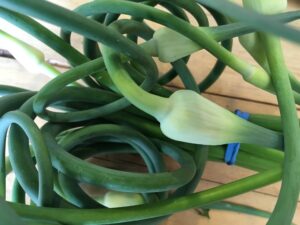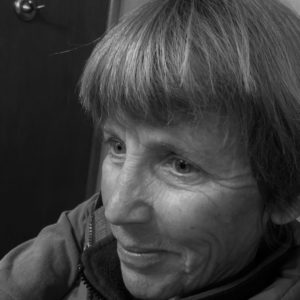 When I was a chubby six-year-old, I had a starring role in a little-known horror film called Blood and Guts. It was written, directed and filmed by a man whose friends and co-workers never suspected his Hitchcockian tendencies. He even had a walk-on role in the movie, á la Hitchcock, in which he played the part of a buxom nanny. This man was my father.
When I was a chubby six-year-old, I had a starring role in a little-known horror film called Blood and Guts. It was written, directed and filmed by a man whose friends and co-workers never suspected his Hitchcockian tendencies. He even had a walk-on role in the movie, á la Hitchcock, in which he played the part of a buxom nanny. This man was my father.
We lived in New York City at the time, but the filming took place at my grandmother’s house in New Jersey where we spent every summer. A great big chunk of New Jersey was its own horror film in the late 1950s, or so ran its reputation. Industry along the turnpike belched smelly black smoke that had us rolling up the car windows and crying out, “Pigs, you stink!” Pigs probably had little to do with it; in that part of the state there wasn’t a farm animal in sight. But farther out, towards Bernardsville, cows grazed and the land got lush. Here was the garden state of New Jersey’s license plate.
My grandmother’s garden was glorious: beets, carrots, string beans, tomatoes, and every kind of lettuce you could think of. We were city kids but we knew about walking barefoot between the rows to yank a beet from the ground. No matter how carefully we washed the dirt off them, they still had a strange, biting aftertaste that clung to our tongues, and they stained our clothes magnificently. The summer sky, when not host to thick thunderclouds, ran pale and hazy, and the humidity forced us into my grandmother’s brilliant blue swimming pool. My mother lay in the sun and my father worked in the city, commuting every day by train. We kids did nothing but play and eat Dairy Queen sundaes and read books and talk back to our mother. Maybe it was our talking back and our unemployed state that inspired my father to make the movie. All I know is that in the hottest days of the hottest July on record in New Jersey, our director decided to start filming.
The movie’s plot line was simple but unsavory—so unsavory, in fact, I’d be wise not to reveal it here. The world has changed since 1959 when my father bought an eight millimeter camera and decided to put his own twist on home movies. Back then, horror films were more amusing than horrifying, a kind of slapstick entertainment that might involve three naughty children tying their mother to the railroad tracks and jumping up and down as the train approached. Throw in a visiting devil, equipped with horns and a tail, and a black cat, and you have yourself a nightmare of Freudian proportions. How could we have had so much fun creating something that sounds so disturbing? It was a family project. Instead of going camping together we stayed home and tied our mom to the railroad tracks—while Dad kept the camera rolling.
All week I looked forward to the weekend when I’d wake up and be in his movie. It started when we picked him up at the train on Friday evening. My mother drove us to the station in our pajamas. Dad would get in the Rambler on the passenger side, and if we didn’t go to the Dairy Queen we’d race the train home. The road from the station paralleled the tracks for miles before turning sharply and shooting over the crossing and up the hill to our house. Out of the station, my mother accelerated and we kids bounced around in the car, shouting encouragement as we pulled ahead or lagged behind the speeding train. We could see Dad’s fellow commuters, all looking as fathers looked to us, tucked behind their newspapers in identical squares of yellow window light. If we were lucky, we’d hit the tracks just as the crossing bells started up, and my mother would laugh and fly across and wait, looking back at the train.
We were mesmerized by trains. The forlorn cries of the train woke me most nights, the lament of a lone machine hurtling through darkness. The pounding wheels gave me goosebumps; they still do. Some evenings we kids would put a penny on the track, and after the Erie Lackawanna went by we’d find a squashed piece of copper, too hot to hold. It was terrifying and exhilarating to be in the presence of such a swift and complete transformation: a penny was no longer a penny. This was our first deep dive into the crucible.
When the day finally came to film the finale of Blood and Guts, the temperature spiked at 102 degrees under an anemic New Jersey sky. The summer was almost over. We were thinking of other things—school and friends—and we weren’t much in the mood for killing off our mother. We knew the movie was a story and every story had an ending. We knew our father had researched the Erie Lackawanna timetable—in fact, he held it in his hand—and that our mother wouldn’t actually be tied to the tracks, she would only be wrapped in rope. We knew her screaming was only some first-rate acting, and we certainly knew the tomato juice we were instructed to lap up wasn’t her blood. We even knew that had the movie been shot in black and white, we would be spooning up Bosco chocolate syrup instead of that terrible tomato juice. We knew these things, and yet we hesitated. Act happy, said my father from behind the camera. Jump up and down. But our performance wasn’t any good that day. We were puffy-eyed from crying as we went through the motions.
I have a clear memory of jumping into my grandmother’s pool at the end of that afternoon—not just because the day was hot, sticky and unbearable, but because I needed absolution. Over the next year, I watched my mother closely, tracking her absences, her frequent fights with my dad. I had seen her die once, on the tracks, and if a penny was no longer a penny, who might she be now? I kept my eye on my father, too, wondering if he was still the director of our movie, and if so, who was I? Would I forever be the chubby little girl in the pink puff-sleeved dress, bargaining with the devil, drinking her mother’s blood? I had a feeling, if I didn’t pay attention, I would live inside my parents’ movie for the rest of my life.

